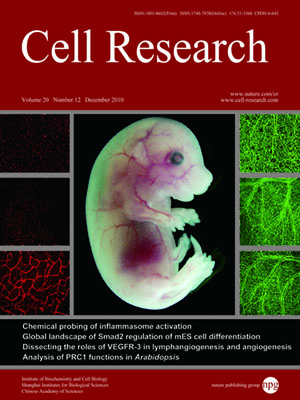
Volume 20, No 12, Dec 2010
ISSN: 1001-0602
EISSN: 1748-7838 2018
impact factor 17.848*
(Clarivate Analytics, 2019)
Volume 20 Issue 12, December 2010: 1289-1305
ORIGINAL ARTICLES
Chemical probing reveals insights into the signaling mechanism of inflammasome activation
Yi-Nan Gong1,2, Xiaoming Wang2,4, Jiayi Wang2,4, Zhenxiao Yang2,4, Shan Li2, Jieling Yang2, Liping Liu2, Xiaoguang Lei2,3 and Feng Shao2
1College of Life Sciences, Beijing Normal University, Beijing 100875, China
2National Institute of Biological Sciences, #7 Science Park Rd, Zhongguancun Life Science Park, Beijing 102206, China
3School of Pharmaceutical Science and Technology, Tianjin University, Tianjin 300072, China
4Graduate School of Chinese Academy of Medical Sciences and Peking Union Medical College, Beijing 100730, China
Correspondence: Feng Shao,(shaofeng@nibs.ac.cn)
Caspase-1-mediated IL-1β production is generally controlled by two pathways. Toll-like receptors (TLRs) recognize pathogen-derived products and induce NF-κB-dependent pro-IL-1β transcription; NOD-like receptors (NLRs) assemble caspase-1-activating inflammasome complexes that sense bacterial products/danger signals. Through a targeted chemical screen, we identify bromoxone, a marine natural product, as a specific and potent inhibitor of the caspase-1 pathway. Bromoxone is effective over diverse inflammatory stimuli including TLR ligands plus ATP/nigericin, cytosolic DNA, flagellin and
Bacillus anthracis lethal toxin. Bromoxone also efficiently suppresses caspase-1 activation triggered by several types of bacterial infection. Bromoxone acts upstream or at the level of the inflammasome in a transcription-independent manner. Bromoxone also inhibits pro-IL-1β expression by targeting components upstream of IKK in the TLR-NF-κB pathway. The unique dual activities of bromoxone are shared by the known TAK1 inhibitor that specifically blocks Nalp3 inflammasome activation. Hinted from the mechanistic and pharmacological properties of bromoxone, we further discover that several known NF-κB inhibitors that act upstream of IKK, but not those targeting IKK or IKK downstream, are potent blockers of different NLRs-mediated caspase-1 activation. Our study uncovers a possible non-transcriptional molecular link between the NLR (Nalp3)-mediated inflammasome pathway and TLR-NF-κB signaling, and suggests a potential strategy to develop new anti-inflammatory drugs.
Cell Research (2010) 20:1289-1305. doi:10.1038/cr.2010.135; published online 21 September 2010
FULL TEXT | PDF
Browse 2286


